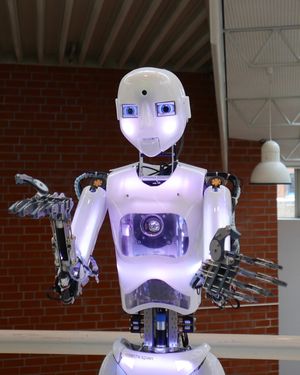KANBrief 2/17

The use of autonomous technologies draws attention to the relationships between human beings and machines. How, though, should our "steel colleagues" look and behave in order for cooperation with them to be agreeable for workers? In order for human-robot collaborative workplaces to be successful, consideration must be given not only to the objective safety of workers, but also to their subjectively perceived safety.
Robots and artificial intelligence are topics rich in fascination and ingenuity. At the same time, they are a source of apprehension and are not without their problems from a psychological perspective. According to a study conducted by the European Commission (pdf), people are particularly sceptical of the use of robots in the social sphere, for example in childcare or care of the elderly. By contrast, their use in manufacturing, security, cleaning or medical applications meets with high acceptance.
Robot use set to double by 2019
In its 2016 annual report, the International Federation of Robotics (IFR) predicted that by 2019, 2.6 million robots will be working in industry worldwide. This would be almost double the current number. The federation identified the human-machine interface as one of the most important challenges and in fact as an element crucial to the market. In the long term, the sector will be dominated by builders of robots that not only perform their tasks efficiently, but are also user-friendly, communicative, and act in an agreeable way.
Many robotics experts are of the opinion that harmonious collaboration with humans can most easily be achieved with machines that to some extent look like human beings and also behave like them. The majority of working environments were after all originally designed for the human body, and should therefore be very suitable for humanoid robots. A second frequently heard argument is that communication between human beings and humanoids is particularly intuitive, since a new mode of interaction does not need to be learnt. Humans could simply speak to robots and interpret their facial expressions and gestures as if they were also human beings.
Predictability is important for team work
In the view of psychological research however, the development of robots that are overly human presents risks. Highly humanoid machines often trigger aversion in us humans: when we are unable to classify our counterparts spontaneously as human beings or machines, when we cannot determine what to expect from the creature, how intelligent it is and whether it will observe the rules of interpersonal behaviour, the robot may even appear downright creepy.
We get on better with robots that are still clearly recognizable as machines. This naturally puts the traditional industrial robot, which with its swivel arms and metallic surface finish can hardly hide its mechanical nature, at an advantage. Here too however, certain aspects must be considered, and once again the issue is that of predictability. The ability to predict the objective pursued by a collaborative partner and the action that this partner will perform in the next step is crucial for good teamwork.
Efficiency requires agreeability
A laboratory experiment conducted by the Carnegie Mellon University (pdf) simulated a café situation in which a robot and test persons shared the handling of orders for drinks. The robot handed its partners a number of different drinking vessels in an unknown order. The test persons were required to add the appropriate ingredients, such as a teabag. It was found that the working time required was shortest not when the robot reached for the next cup in a loss-free straight-line trajectory, but when the robot's arm movements followed a curve and it was therefore easy to predict what the robot would grasp next. The form of movement optimized for human perception was however not only the most efficient, but was also ranked by the test persons as being the most agreeable, by a wide margin.
The influence of subjective perception upon the flow of work should therefore never be underestimated. In human-robot collaboration, personal well-being is dependent, among other things, upon proactive signals from the robot. The better it signals its intentions to the human beings in its environment, the more trust they are able to have in it.
Dr. Martina Mara martina.mara@aec.at